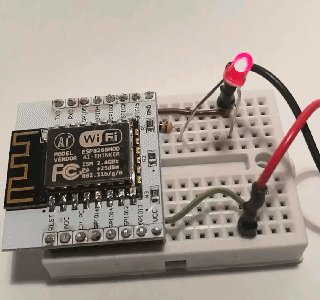As a DIY fan I love to browse internet in search of ideas and inspirations. So I've found a pretty nice project, called ESPBASIC. I heard about BASIC, but I had never had a chance neither to learn it nor to use it, so I thought it was 's time to meet BASIC (although it's just an interpreter). I have few ESP-12F chips in my drawer, few cables and LEDs scattered around and a free breadboard, and that will be enough for the first encounter with BASIC. My idea is simple and typical for electronics - I have decided to make hello world of DIY world - blinking LED.
Burning chips
There are a few steps:
- Connect uC to any UART controller (I'm using pl2303)
- Download a flashing tool from the official website
- Select a port and flash firmware
I had only one problem there - drivers. Windows 10 is a bit too strict about drivers, so I had to download old version of my pl2303 driver and everything goes fine. Except that I think it's one of easiest firmwares to install.
Connecting
On your WiFi AP list should appear one more network called like ESP AA:BB:CC:DD:EE:FF. Just connect to it, discover device's IP (it should be 192.168.4.1) and put it into the browser.
Your eyes should see something like this:

In SETTINGS tab you can configure ESP to connect to your home wifi, setup OTA url (eg. url to BASIC file hosted on GitHub)
Hello world
ESPBASIC has nearly a plaintext, one-paged documentation:
https://docs.google.com/document/d/1EiYugfu12X2_pmfmu2O19CcLX0ALgLM4r2YxKYyJon8/pub
So I tried to put Hello World on my screen with the following code in [EDIT] tab:
print "Hello World"
Then Save file and [RUN] the code.

Yeah! It was easy. But if you want to put one more print, you will see garbage (<hr> tag) above your text. Quickly look into documentation and you should find out there also wprint function, that put text on screen without any additional code.
Going blinky
I've connected LED to ESP-12's GPIO15 pin. Firstly I will try to just light my light up.
print "Led ON"
io(po,15,1)
First try and it works! Just with one line, wireless, without compilation and without flashing. Wow!
io is just a IO operation function
po means 'pin out'
15 is pin number
1 is high state (0 is low)
Next step is to make a delay between turning LED on and off:
io(po,15,1)
delay 500
io(po,15,0)
delay 500
io(po,15,1)
delay 500
io(po,15,0)
delay 500
io(po,15,1)
delay 500
io(po,15,0)
delay 500
And it blinks, but only few times with 0.5s delay. Last thing I need there is any loop here, and then I will have an awesome blinking machine!
For x = 1 to 60
io(po,15,1)
delay 500
io(po,15,0)
delay 500
Next x
This code lasts after 60 seconds. Let's make it infinite!

variable = 0
Do
io(po,15,variable % 2)
delay 500
variable = variable + 1
Loop until 0 'infinite
Success! But ESP's "IDE" becomes unavailable. The reason is that delay operation takes all processor time.
It's better to use timer functions, which uses interrupts to count time.
variable = 0
Timer 500, [blink]
[blink]
io(po,15,variable % 2)
variable = variable + 1
wait
Timer takes CPU time only every about 500ms, so it's possible to edit code and keep it running in the background.
This post is cross posted with my company blog.